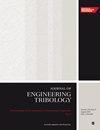纳米尺度磨损:对影响纳米摩擦学的测量方法和参数的评述
IF 1.8
3区 工程技术
Q3 ENGINEERING, MECHANICAL
Proceedings of the Institution of Mechanical Engineers, Part J: Journal of Engineering Tribology
Pub Date : 2023-11-07
DOI:10.1177/13506501231207525
引用次数: 0
摘要
本文对纳米尺度磨损中影响纳米摩擦学的测量方法和参数进行了综述。纳米尺度的磨损现象在包括微/纳米系统、电子和生物技术在内的各个行业中发挥着至关重要的作用。本文首先讨论了纳米级磨损的重要性及其对器件性能、寿命、耐久性、能源效率、成本节约和环境可持续性的影响。然后深入研究了用于评估纳米级磨损的测量方法,包括扫描探针显微镜(SPM)技术,如原子力显微镜(AFM)和摩擦力显微镜(FFM)。强调了AFM和FFM在研究表面粗糙度、粘附、摩擦、划伤、磨损和纳米尺度材料转移方面的能力。此外,本文还探讨了影响纳米磨损的参数,如润滑策略、应力水平、滑动速度和原子尺度反应。文章最后强调了先进的显微技术在理解不同尺度的摩擦学机制方面的重要性,弥合了宏观和纳米摩擦学研究之间的差距。本文章由计算机程序翻译,如有差异,请以英文原文为准。
Nano-scale wear: A critical review on its measuring methods and parameters affecting nano-tribology
This paper presents a critical review on the measuring methods and parameters affecting nano-tribology in the context of nano-scale wear. Nano-scale wear phenomena play a crucial role in various industries, including micro/nano-systems, electronics, and biotechnology. The review begins by discussing the significance of nano-scale wear and its impact on device performance, lifespan, durability, energy efficiency, cost savings, and environmental sustainability. It then delves into the measuring methods employed to assess nano-scale wear, including scanning probe microscopy (SPM) techniques such as atomic force microscopy (AFM) and friction force microscopy (FFM). The capabilities of AFM and FFM in studying the roughness of surface, adhesion, friction, scratch, abrasion, and nano-scale material transfer are highlighted. Additionally, the review explores the parameters affecting nano-wear, such as lubrication strategies, stress levels, sliding velocity, and atomic-scale reactions. The article concludes by emphasizing the importance of advanced microscopy techniques in understanding tribological mechanisms at different scales, bridging the gap between macro and nano-tribology studies.
求助全文
通过发布文献求助,成功后即可免费获取论文全文。
去求助
来源期刊

CiteScore
4.20
自引率
5.00%
发文量
110
审稿时长
6.1 months
期刊介绍:
The Journal of Engineering Tribology publishes high-quality, peer-reviewed papers from academia and industry worldwide on the engineering science associated with tribology and its applications.
"I am proud to say that I have been part of the tribology research community for almost 20 years. That community has always seemed to me to be highly active, progressive, and closely knit. The conferences are well attended and are characterised by a warmth and friendliness that transcends national boundaries. I see Part J as being an important part of that community, giving us an outlet to publish and promote our scholarly activities. I very much look forward to my term of office as editor of your Journal. I hope you will continue to submit papers, help out with reviewing, and most importantly to read and talk about the work you will find there." Professor Rob Dwyer-Joyce, Sheffield University, UK
This journal is a member of the Committee on Publication Ethics (COPE).
 求助内容:
求助内容: 应助结果提醒方式:
应助结果提醒方式:


